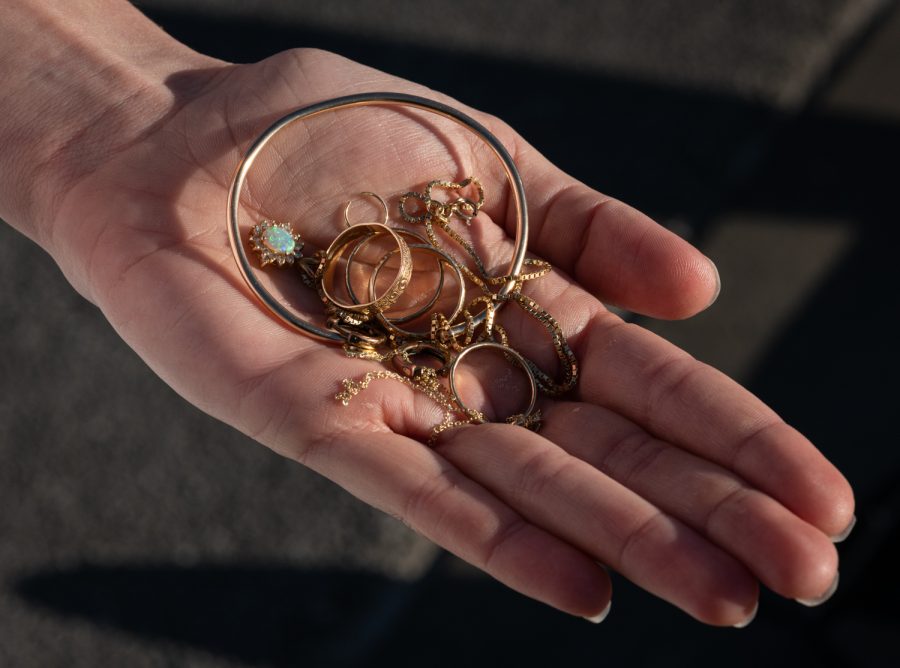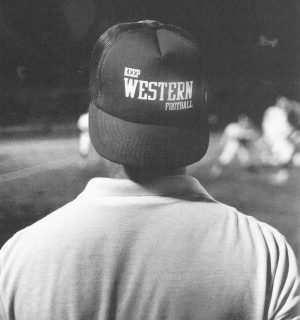Going for gold: WKU student-athletes share what their jewelry means to them
Western Kentucky University student volleyball and track star Katie Isenbarger wears an assortment of gold jewelry when she competes in the high jump. In total, she wears three piercings on each ear (and an extra fourth, on one side), one simple thin wire-cuff bracelet, two hand-made friendship anklets, two necklaces, and four rings. Isenbarger says it’s a way to maintain individuality while competing in uniform. “It’s what I wear every single day,” she says.
April 29, 2022
The young woman uniformed in red and white began her run up to the bar. Spectators quieted in the stands. Running in an arc, she curved in parallel to the obstacle. One, then two feet left the ground and followed her head, neck, shoulders, torso, hips, then knees and ankles as she sailed backward over the pole.
Katie Isenbarger, a WKU senior and member of the Hilltoppers’ track and field program, just broke her two-year hiatus from the high jump by shattering her previous personal record and securing first place at the Lenny Lyles Invitational in Louisville on January 29.
Isenbarger landed on the mat with a whoomph and leapt back up, beaming, her pendants and necklaces bobbing from her neck. She shattered her PR without even taking off her jewelry.
Pieces of individuality
College athletes wear uniforms when competing. Across different teams and sports, they differ wildly by cut, color and design. But every one of these outfits share a common purpose—to unite the wearers as one with their team and their school.
Competing in personal, unbranded accessories like jewelry remains one of the few fashion-based methods athletes have for differentiating themselves from their teammates. Personal jewelry adds a touch of individuality to their athletic personas.
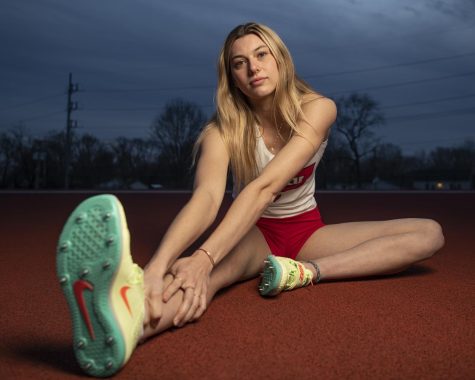
From elementary school competition all the way up through the Olympics, earrings, rings, necklaces, anklets and bracelets are found everywhere.
“It’s a way for an athlete to express an individual style,” Brent Chumbley, head coach of WKU’s track and field program, said.
In other sports like soccer, football or basketball, Chumbley said most jewelry is banned as it poses a hazard. Since running and track events are “non-contact sports”, Chumbley said he sees no safety issue with his team wearing jewelry in competition.
“As long as it’s not hindering performance, I support it,” Chumbley said.
Pieces of family, religion, home
Isenbarger said the only time she removes any of her jewelry during track and field season is before weight training. Even then, she only removes her rings, for fear a weighted bar might deform them. She wears three gold rings one hand.
“I wanted them to be simple—that’s why I like the band(s)”, Isenbarger said. “But I did like the intricate detailing [which] I thought made it look expensive.”
All told, she usually wears around 14 pieces of solid, filled or plated gold—one wire bracelet, two necklaces with pendants, two earrings, four rings and five ear piercings.
Her favorite piece is a delicate gold chain with a pendant bearing one white-opal cabochon, set above a bed of small diamonds. Isenbarger said the piece was originally a gift from her father to her mother.
“I kind of stole it from her,” Isenbarger said, laughing sheepishly.
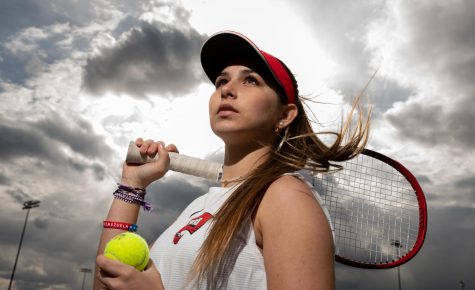
Sophomore marketing student and WKU tennis player Samantha Martinez, hailing from La Guairá, Venezuela, sports a simple, elastic wristband as an expression of national pride. Reminiscent of the Venezuelan flag, her bracelet bears white stars over a pattern of red, blue, and yellow.
“It motivates me when I look at it, because I’m not only representing the team, but also my country,” Martinez said. She purchased it roughly a year ago when she moved from Venezuela to Bowling Green to play tennis at the collegiate level.
Alongside the wristband is a colorful set of four string-bracelets bearing knots, patterns and beads. These, Martinez said, have identical companion pieces worn by her family and friends.
Though Isenbarger may not accessorize for national pride, she does wear pieces of her own to honor relationships and loved ones. One of Isenbarger’s newest acquisitions bears a capital “R” for her boyfriend, Ryan Luckett.
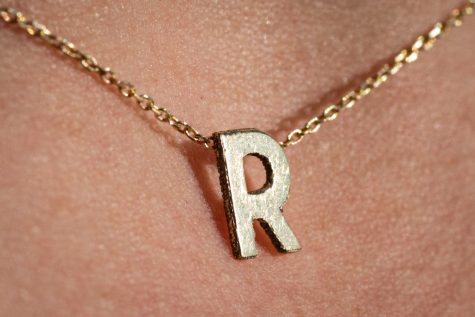
“It was a one-year anniversary gift,” Luckett said. He said he bought her the necklace from a vendor on Etsy after she’d mentioned her volleyball teammates had similar pieces.
Isenbarger also wears a two-stack of handmade anklets. Fastened just above her right foot with a series of knots rendered intractable by time, she said these two pieces never come off. The top piece, fashioned from durable paracord, has a handful of matching companions, she said.
“I made this exact bracelet for my mom, my best friend, and people on the volleyball team, too,” Isenbarger said.
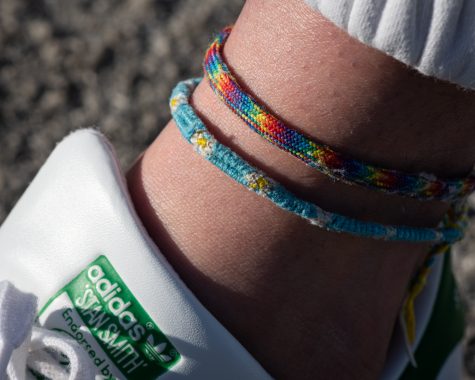
Though Isenbarger and Martinez do share similar reasons for wearing their jewelry, their practice is by no means exclusive to women.
WKU Baseball senior pitcher Sean Bergeron wears several necklaces of his own. Two were gifts from his mother – he said that he wears them to “always have a piece of her with me.”
Bergeron, a non-denominational Christian, says that one of the chains bears a cross, which lends that piece an additional meaning.
“I guess it’s also to say that I have a piece of Him with me, too,” Bergeron said.
Pieces of empowerment
“In a uniform, everyone looks the same, but that’s just not the nature of people,” Carrie Cox, a professor of fashion and merchandising at WKU, said. Cox said says she thinks there’s a possibility that allowing athletes to wear jewelry could positively impact performance and be “empowering.”
“Psychologically, it may be beneficial,” Cox said. Whether it’s an expression of religion, family, nationality, love, family or friendships, she said it may help athletes feel more confident on the field. Chumbley agrees.
“I think it has an impact on a student athlete’s ability to perform,” Chumbley said.
Staff photographer Arthur Trickett-Wile can be reached at [email protected].

